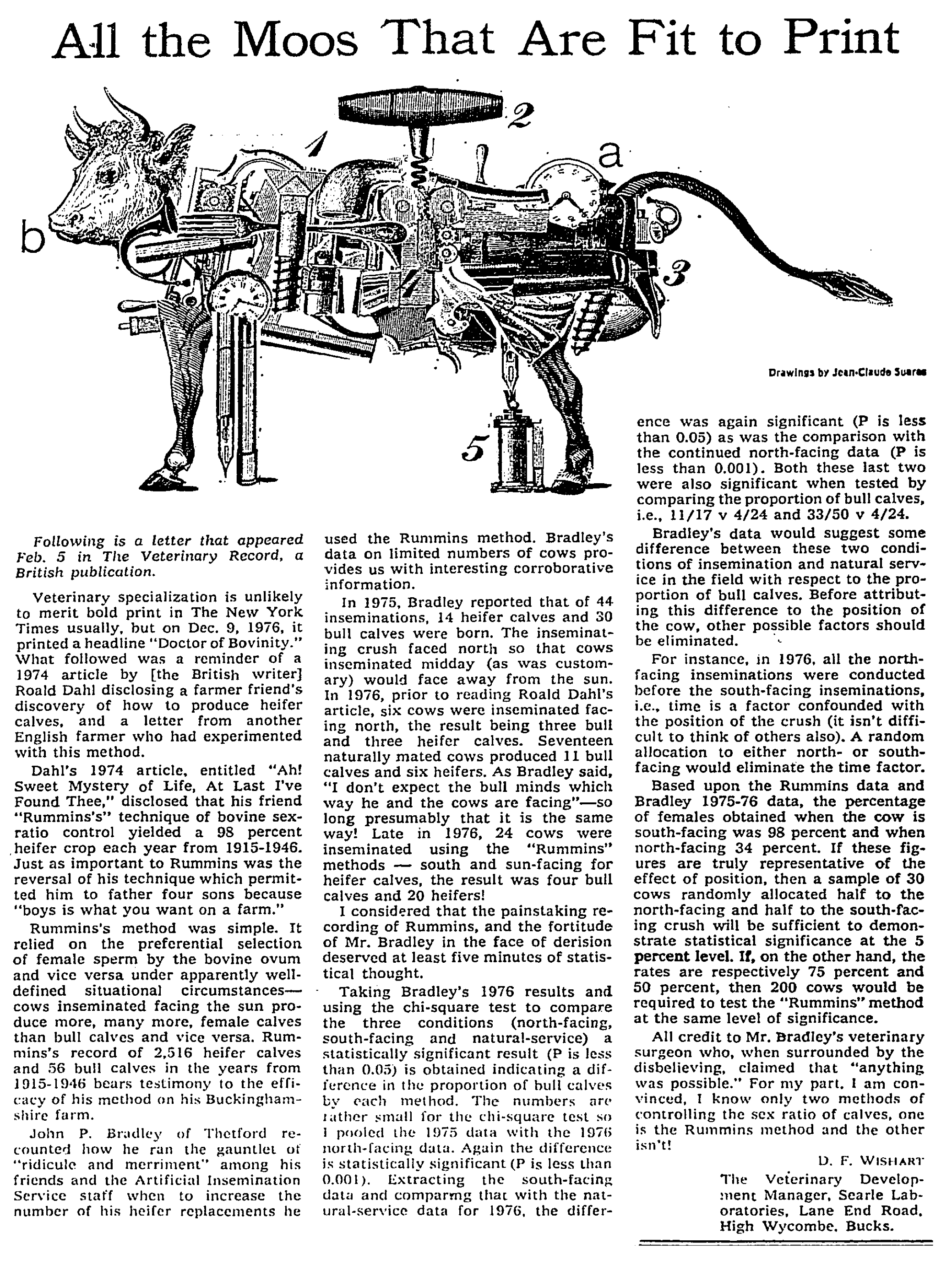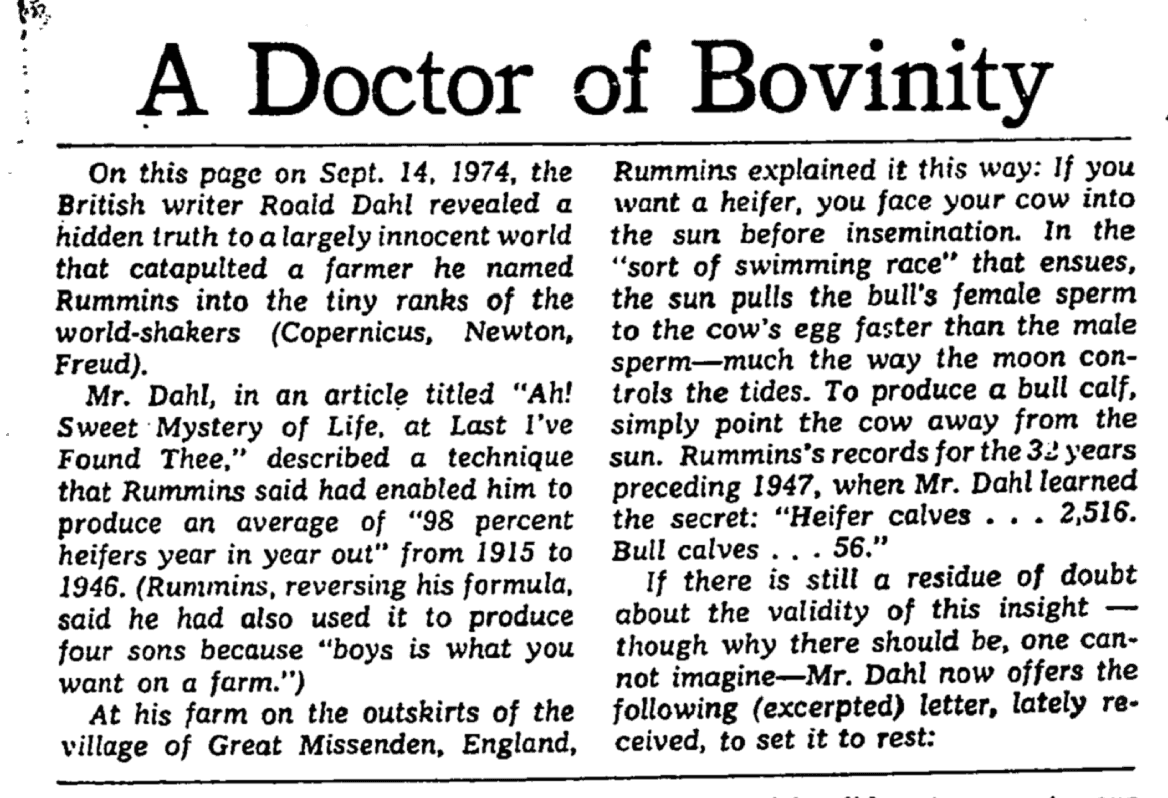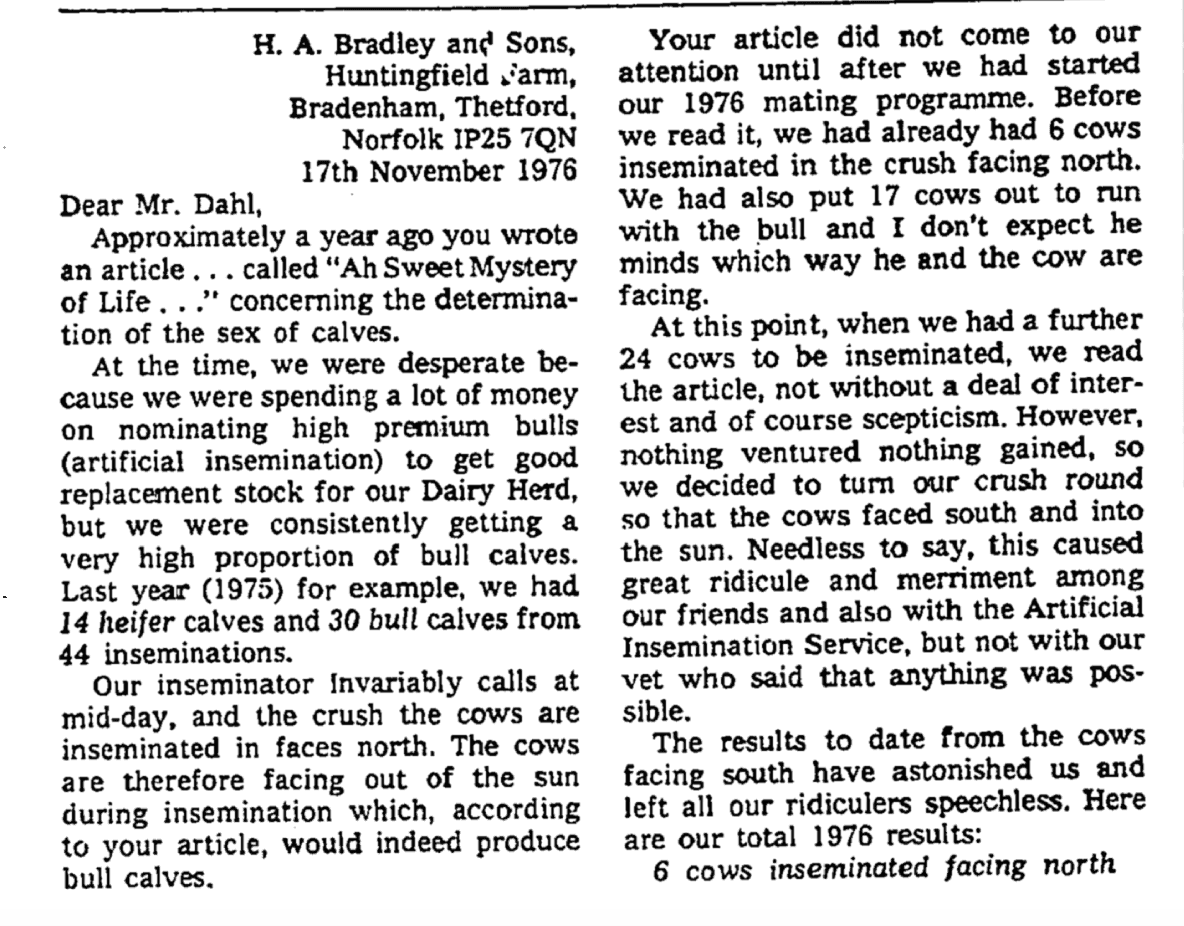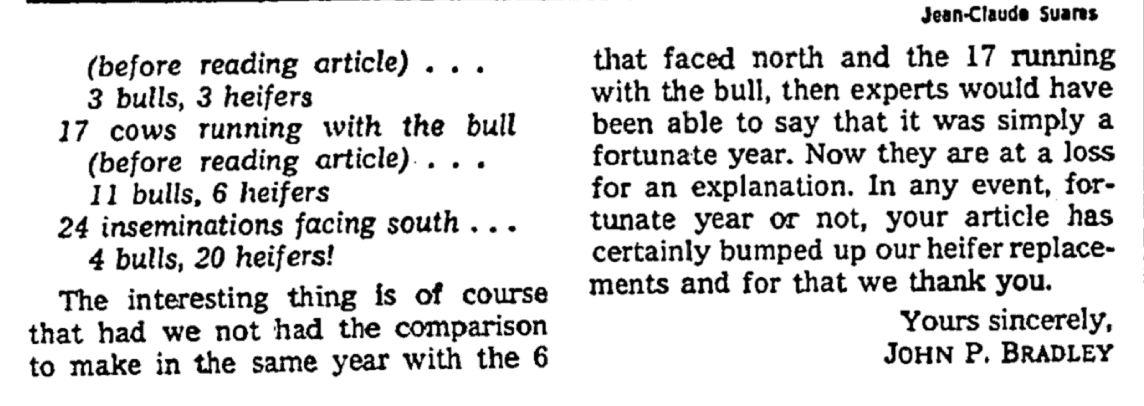This letter was published in Veterinary Record on February 5, 1977.

This letter was published in Veterinary Record on February 5, 1977.

This letter was published in The New York Times on December 9, 1976.



Sections: Information | Introduction | Plot Description | Fun Stuff
Roald Dahl introduces this version of the story as if it happened to him!
The other day, when this newspaper invited me to write a short piece on more or less any subject, I declined. I was struggling with a new children’s book, I said, and I find it difficult to switch over from one thing to another. But I had no sooner replaced the receiver when I began to have second thoughts.
The New York Times, I told myself, is read by just about everybody of consequence in the United States, including the President himself. So what a tremendous opportunity this would be to say something of world-shaking importance and to implant the message directly into the minds of powerful men.
But did I have such a message? Nothing in the lead bit trivial would do. Nothing political or witty or smart-aleck. It must, in fact, be something of major benefit to mankind the world over. Something along the lines of Salk and his polio vaccine or Roentgen with his exposed photographic plate or Fleming with that little bacteria-free circle on the watch glass. Something like that.
Well now, I thought. And I went on thinking and thinking and nothing much happened….until suddenly click went a little trigger somewhere inside the head and I cried out, “I’ve got it!” And indeed I had.
For the last 27 ears I have been stewing and brewing about an incident that took place one misty autumn afternoon in a farmyard on the outskirts of the village of Great Missenden, and I have many times wondered where and when I should make the facts known tot he world. This surely was my chance. So here we go. The story is a true one.
Back in 1947 when there was still a postwar shortage of milk in England, we kept a cow in our orchard. The house I was then living in with my mother and my youngest sister is presently owned by Mr. Harold Wilson, the Prime Minister. So this is the orchard. I mention this for a reason. When my story breaks upon the world, thousands of people will flock to Great Missenden to stand and stare at the house where i tall started. And Mr. Wilson, who is no less of an egomaniac than any other politician, will almost certainly think they have come to look at him. He will probably wave to them from an upstairs window and he may even try to make an electioneering speech. If he does, he will be jeered.
This version is slightly different from the later one published in Ah, Sweet Mystery of Life. Claud doesn’t appear at all, for example, and there’s no description of the bull’s, uh, equipment. Dahl also claims that the story is true and happened to him personally in 1947 in Great Missenden.
Spoiler warning! Dahl’s cow started “bulling” so he took her down the road to be serviced by Rummins’s bull. Rummins explains he has a unique way of conducting an official mating that no one else in the world knows. Pointing the cow into the sun, he says, means that a heifer (female) will result, while pointing her away creates a bull (male). The actual reason has something to do with the pull the sun exerts on “female” sperm. After Dahl checks the records to verify this claim, he asks Rummins if it will work with people. “Of course it’ll work with humans,” he said. “…I’ve got four boys of my own, ain’t I?”
Sections: Information | Plot Description | Fun Stuff
This is the first story in which we meet Oswald Hendryks Cornelius, noted seducer extraordinaire. It’s a story-within-a-story that begins as the narrator explains how he came to inherit all 28 volumes of his uncle’s memoirs. It’s interesting to note that the narrator seems to be Dahl himself: a letter from Oswald makes reference to “you and your three sisters,” and Dahl, of course, had three sisters himself. Note: this is a very adult story in tone and probably shouldn’t be read by any children without permission from their parents.
Spoiler warning! After inheriting his long-absent uncle’s books, the narrator reads through them all and desperately wants them to be published and shared with the world. Unfortunately the books contain many salacious details, including the names of many (married) woman that Oswald slept with and whose husbands would not find such a scandal appealing. After consulting with a lawyer, the narrator determines that the “Sinai Desert Episode” is probably safe to print. Before launching into this, the very last entry from the diary, the narrator describes his uncle and the singular effect he seems to have had on women. He was a fastidious man who collected walking sticks, ties made from spider silk, and Chinese porcelain. He had a way of speaking that seemed to hypnotize the listener (usually a woman) and put her into a spell of lust.
The Sinai Desert episode is dated 1946 and involves Oswald’s escape from Cairo following a romantic rendezvous with an aristocratic Moorish woman (and another man’s mistress). He decides to drive to Jerusalem via the desert road and search for scorpions to add to his collection. He succeeds with the scorpion but when he stops for gasoline the diseased attendant tells him that his fan belt has broken. He will have to spend the night in the desert and wait for a new fan belt to arrive. As Oswald resigns himself to this, a Rolls-Royce drives up and a wealthy man steps out. They quickly get to know each other and the rich man, Abdul Aziz, invites Oswald to spend the night at his house nearby. The man explains on the way that he chooses to live in such a wild location in order to protect his beautiful young daughter from the unwanted attention of men. Oswald is astounded when he meets the mother and daughter, and he can’t make his mind up which one he wants to seduce. They both go immediately to their own bedrooms, though, without giving him any indication of a possible rendezvous. He is disappointed but prepares to go to sleep. In the middle of the night, his door opens and a woman climbs into bed with him. After hours of energetic lovemaking, she slips out as silently as she arrived. Oswald believes he will be able to tell which it was by a bite mark he has left on her neck. But the next morning, BOTH of them are wearing scarves! As Abdul drives him back to the gas station, Oswald fishes for an invitation back to the house. Abdul doesn’t take the bait, though, and after a while he admits that there is another reason he lives in such an isolated spot. He has another daughter living in the house… and she has leprosy. “Dear fellow, you mustn’t alarm yourself like this,” he tells Oswald. “You have to have the most intimate contact with the person in order to catch it…” Shaking, Oswald returns to his repaired car and watches the Rolls-Royce drive back off across the desert.
Sections: Information | Plot Description | Reviews
This is not a nice story. In fact, it’s probably my least favorite Dahl story of all. It should not be read by any children. It’s full of disturbing violence and sexual content, so I’m going to keep this synopsis as vague as possible. Read at your own risk.
Spoiler warning! When Anna Cooper finds out that her beloved husband Ed has been killed in a car accident, it nearly drives her crazy. They were so completely in love that she doesn’t think she can survive without him. Her children manage to convince her to carry on, but soon they’re all moved out and busy with their own lives. Anna misses Ed so much that she decides to kill herself. Before she can do it, though, her friend Liz talks her into helping out at Liz’s adoption society office. Anna discovers that hard work makes her feel needed and that life is once again worth living. After a year and a half of this, she feels that she’s “back in the swim” once again. It’s then that she has to take a business trip to Dallas, Texas to deal with a particularly difficult adoption case. In the hotel, Anna starts to feel frightened and alone. She remembers conversations she had with Ed about Texas. She needs a friend. Suddenly she remembers that Conrad Kreuger lives in Dallas. Conrad was her high school sweetheart and they had planned to get married. Then, of course, Anna had met Ed and left Conrad, and Conrad had married another girl named Araminty. She decides to call him up and, to her surprise, he suggests meeting her at the hotel for a drink. Anna is nervous about this, but feels her psychiatrist back home would be pleased (as he’s always telling her that she needs to “physically replace” Ed). She meets Conrad and is happy to see that he looks as handsome as ever. When she orders a gin martini, he frowns and tells her why gin is not good for women. That’s when Anna discovers that Conrad is now a gynaecologist. She and Conrad talk and she learns that his marriage only lasted two years and that he has almost no contact with his son. She commiserates and tells him the whole story of Ed’s death and her suicidal tendencies. After another discussion of how mentholated cigarettes are bad for women, Conrad lets it slip that he is still bitter about the way Anna jilted him. She is surprised, but he tells her that he was wildly in love with her. Then he suggests that the two of them might… “have a bit of unfinished business.” Anna isn’t sure how she feels about sleeping with another man. After a third martini, though, she’s floating and allows herself to be led back up to her hotel room. She and Conrad kiss for a while, and Anna begins to feel excited about being with him. He continues to make odd medical references, but she shushes him. Conrad is strangely clinical as he removes his clothes and prepares to make love to her. In the middle of the act, though, he feels an obstruction and she begins to feel sick. She wants him to leave but instead he pins her down and begins telling her precisely what is medically wrong with her. She’s nearly hysterical now and struggles to get him off her. Finally she begins to scream and he pushes her to the floor. She staggers to the bathroom crying “Ed!… Ed!… Ed!…” Conrad hears the click of the medicine cabinet being opened. Quickly he dresses himself, wipes the lipstick off his face, and leaves the room.
Sections: Information | Plot Description | Reviews
This is a very adult story and I would highly recommend that kids don’t read it. Not only is it of a very sexual nature, but it’s got some questionable language too. It’s from Dahl’s book Switch B***h. I’m going to keep the plot description as vague as possible.
Spoiler warning! Vic lusts after Samantha, the wife of his best friend and neighbor Jerry. Samantha is a faithful woman, though, and Vic knows he stands no chance of seducing her. So he concocts a plan that will allow him and Jerry to switch wives for an evening without the women knowing it. He manages to convince Jerry of the plan and the two of them spend many weeks working out the details. On the fateful night, the two men switch beds and make love to the other man’s wife. Then they return home, full of glee at their own cleverness. Vic gets quite a shock the next morning, though, when his wife Mary admits that she’s never really enjoyed sex with him… before last night.
Sections: Information | Plot Description | Reviews | Criticism and Analysis
This story is actually quite disturbing, if you ask me. I’d definitely think twice before letting an impressionable child read it. It has some very vivid passages that can only be described as a Freudian nightmare come to life.
Spoiler warning! George is a vicar in a small country parish and has quite a problem with women. On one hand he is mad about them – the mere sight of a lady in high heels is enough excite him enormously. On the other hand, he can’t bear to touch them or be in close proximity to them. George doesn’t understand the reason for this paradox, but Dahl gives the reader an additional insight – George’s memories of his mother. She was apparently quite a free spirit and took pleasure in teaching her soon the “realities” of life. He quite simply adored her. One night, after a week’s worth of discussions about sex, she took him to the garage to see their rabbit Josephine give birth. As they marvelled at the miracle of life, Josephine began to swallow her new children whole. George screamed, and as he turned to his mother her large open mouth loomed over him and he fled shrieking into the night. She chased him across a highway and was struck by a car and killed. (Undoubtedly this incident affected George deeply and resulted in his subconscious attraction/revulsions towards all women.) Now grown, George tries everything to elude the parish widowers who constantly stalk him. They are persistent though, and George grows more and more desperate with each attempt to seduce him. Finally Miss Roach gets him drunk at a tennis party and catches him in an embrace out in the garden. He is too lightheaded to resist. As she goes to kiss him, though, he sees her large open mouth and begins to scream as she swallows him whole. He continues to narrate from his new home in her digestive system, although we the readers know that he has just simply gone mad. The padded room that he believes is located somewhere near her right kidney is actually in an asylum.
Sections: Information | Plot Description | Spanish Covers
This very adult story was originally published in Playboy and probably shouldn’t be read by any children without the consent of their parents. With that in mind, I’m going to keep the plot/description rather simple and vague.
Spoiler warning! This story is about Mr. William Buggage and his secretary Miss Tottle and the secret business they run out of Buggage’s Rare Book Shop in London. Every day they read the obituaries and draft custom invoices to send to the grieving widow. The invoices list various European books of pornography and sexual deviance. The horrified widows always pay quickly to keep the matter from the presses. Mr. Buggage and Miss Tottle have made thousands of pounds using this method, and they use their ill-gotten gains to take lavish trips together. (They really are disgusting people – rather like The Twits.) Eventually they are caught when one of the widows points out that her late husband was blind and that the invoice is therefore a fake.
Sections: Information | Plot Description | Reviews
This very adult story is from Dahl’s book Switch B***h and probably shouldn’t be read by any children without the consent of their parents. With that in mind, I’m going to keep the plot/description rather simple and vague.
Spoiler warning! Oswald meets up with an olfactory chemist (a scientist of smells) who wants to isolate the human sex pheromone. They accomplish this feat and successfully test the new perfume, which they label “B***h.” Unfortunately the scientist’s lab assistant steals almost all of their supply and then Henri, the scientist, dies of a heart attack during exertions brought on by the pheromone. Armed with only a small remainder and unable to make more, Uncle Oswald decides to have some fun. He plants the liquid in a large flower corsage to be worn by an obnoxious woman sitting next to the President on live television. His plans derail, however, when she unknowingly releases the perfume in his presence in her hotel room. A spectacularly surreal sex scene concludes the story.
Sections: Information | Plot Description
This is a rather ribald tale from Dahl’s “Claud’s Dog” collection of country stories. Each seems rather autobiographical, in that they all take place in Buckinghamshire (the county Dahl lived in), feature characters that he actually knew (the butcher Claud Taylor), and deal with subjects that he himself was interested in (greyhound racing, etc.). “Ah, Sweet Mystery of Life” is an almost anecdotal story about a unique method for ensuring the gender of calves when mating cows.
Spoiler warning! The narrator’s cow has started “bulling” (which means she’s in heat, I think) and he takes her down the road to be serviced by Rummins’s famous bull. Claud points out that Rummins has a unique way of conducting an official mating that no one else in the world knows. As Rummins later explains, pointing the cow into the sun means that a heifer (female) will result, while pointing her away creates a bull (male). The actual reason has something to do with the pull the sun exerts on “female” sperm. After the narrator checks the records to verify this claim, he asks Rummins if it will work with people. “Of course it’ll work with humans,” he said. “…I’ve got four boys of my own, ain’t I?”